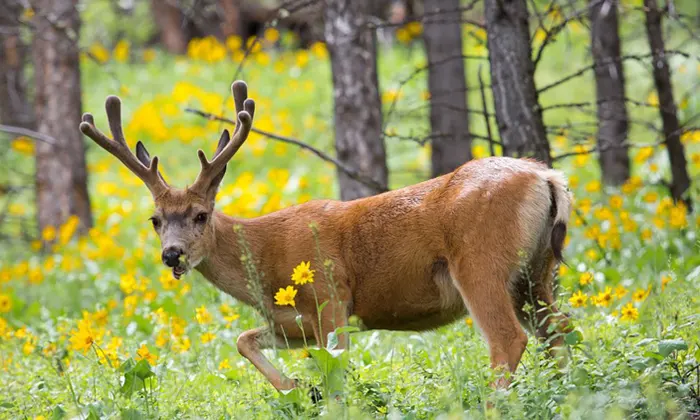Description

Copyright infringement not intended
Picture Courtesy: www.theguardian.com
Context: The emergence of chronic wasting disease (CWD), often referred to as "zombie deer disease," and the potential for it to jump from animals to humans have raised significant concerns among scientists and experts.
Key Highlights
- CWD Spread in Animals: Over the past year, approximately 800 cases of CWD have been identified in deer, elk, and moose in Wyoming, USA. Symptoms in these animals include drooling, lethargy, stumbling, and a vacant stare.
- Risk to Humans: Scientists are warning about the potential for CWD to spread from animals to humans. This concern stems from the unpredictability of such spillover events, drawing parallels with past outbreaks like mad cow disease in the UK.
- Preparedness and Caution: Experts stress the importance of preparedness in case CWD does jump to humans. They highlight the cautionary tale of the UK's experience with mad cow disease, which resulted in human deaths from the variant of the disease.
- Challenges and Persistence of CWD: CWD is difficult to eradicate once it enters an environment. It can persist for years in soil or on surfaces and is resistant to various disinfection methods.
- Broader Threat of Zoonotic Diseases: Beyond CWD, there's a broader concern about zoonotic diseases, those transmitted from animals to humans. Research indicates that these diseases could cause significantly more deaths in the future, attributed to factors like climate change and deforestation.
- Call for Proactive Measures: Scientists emphasize the need for proactive measures to address the potential consequences of diseases like CWD potentially affecting humans. Preparedness and early intervention are considered essential to prevent a potential crisis.

Zombie Deer Disease
- Zombie deer disease, or chronic wasting disease (CWD), is a fatal neurological disorder that affects deer, elk, moose and other members of the cervid family.
- It is caused by misfolded proteins called prions that infect the brain and spinal cord of the animals, leading to weight loss, behavioural changes, loss of coordination and death.
- The disease has been spreading across North America and other parts of the world, posing a serious threat to wildlife conservation and human health.
How Does CWD Spread?
- CWD can be transmitted directly from animal to animal through bodily fluids such as saliva, urine, blood and faeces.
- It can be spread indirectly through contaminated soil, water, plants and equipment. Prions are very resistant to degradation and can persist in the environment for years.
- It has an incubation period of 18 to 24 months, meaning that infected animals may not show any symptoms for a long time. However, they can still shed prions and infect other animals during this period.
Where Is CWD Found?
- CWD was first identified in Colorado in 1967 in captive deer. Since then, it has been detected in 30 U.S. states and four Canadian provinces, as well as Norway, Finland, Sweden and South Korea.
- The disease is most prevalent in the Midwest and Rocky Mountain regions of the U.S., where it affects up to 40% of some deer populations.
- CWD has also been found in Yellowstone National Park for the first time in 2023, raising concerns about the impact on the iconic wildlife and ecosystem there.
What Are the Implications for Wildlife?
- CWD is a serious threat to the health and survival of deer and other cervids. It reduces their reproductive success, increases their mortality rate, alters their social behaviour and makes them more vulnerable to predators and accidents.
- It can have cascading effects on the food web, affecting other species that depend on deer as prey or scavengers. Moreover, CWD can reduce the recreational and economic value of hunting and wildlife-watching activities.
What Are the Risks for Humans?
- There is no conclusive evidence that CWD can infect humans, but there is also no guarantee that it cannot.
- Some studies have shown that CWD can cross the species barrier and infect non-human primates such as monkeys and genetically modified mice.
- Other studies have suggested that there may be a link between CWD exposure and some cases of Creutzfeldt-Jakob disease (CJD), a rare and fatal human prion disease.
- The World Health Organization and the Centers for Disease Control and Prevention recommend that people avoid eating meat from CWD-infected animals as a precautionary measure.
What Can Be Done to Prevent or Control CWD?
- There is no vaccine or treatment for CWD, and once it is established in a wild population, there is no realistic way to eradicate it. Therefore, prevention and early detection are crucial to limit its spread and impact. Some of the strategies that have been implemented or proposed include:
- Testing harvested animals for CWD and disposing of infected carcasses properly.
- Restricting the movement of live animals or animal parts across state or national borders.
- Reducing deer density and contact through hunting or culling.
- Enhancing surveillance and monitoring of CWD occurrence and distribution.
- Educating hunters and the public about CWD risks and prevention measures.
- Supporting research and innovation to develop new tools and methods to combat CWD.

Conclusion
- CWD is a complex and challenging issue that requires collaboration and coordination among various stakeholders, including wildlife managers, hunters, landowners, researchers, policymakers and the public.
|
PRACTICE QUESTION
Q. Which family of animals is primarily affected by Chronic Wasting Disease (CWD)?
A) Felidae (cats)
B) Canidae (dogs)
C) Cervidae (deer, elk, moose)
D) Bovidae (cattle, goats)
Answer: C
Explanation: CWD primarily affects animals in the deer family (cervids), such as deer, elk, and moose.
|
















